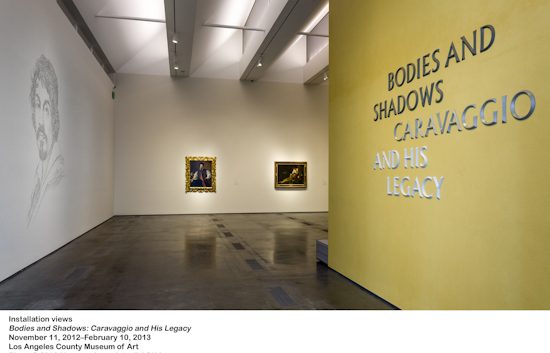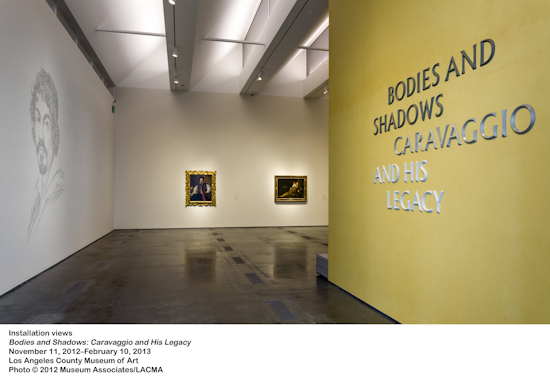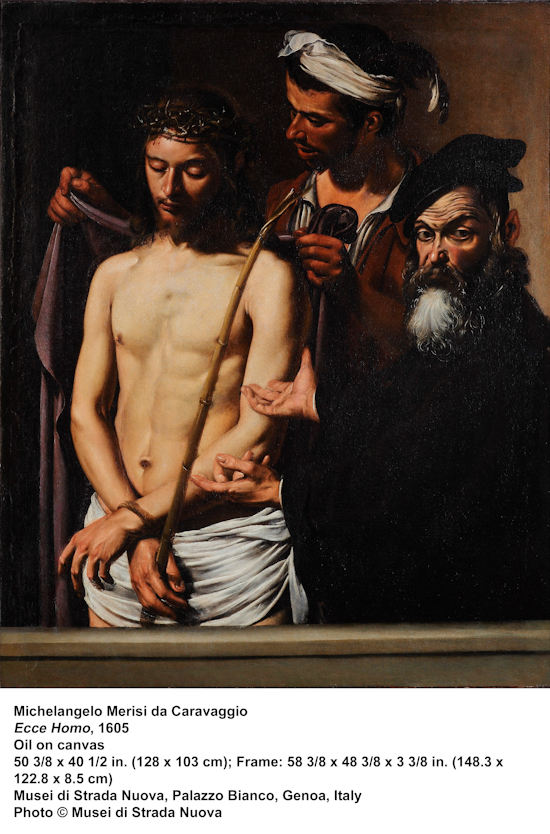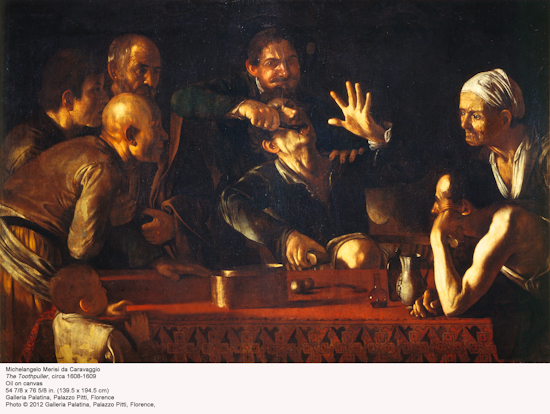Caravaggio, Caravaggio!


Let there be light and then let there be darkness! This is perhaps the story of Caravaggio, who was not just one of the greatest painters ever to have lived but also a true revolutionary in both spirit and technique. Eight of his paintings are currently on display at LACMA as part of a massive homage to him and the many, many painters he influenced – fifty of their works are part of the exhibit as well. Here, in Part 1, we view the man himself and his displayed works, one by one.
His real name is Michelangelo Merisi and he is born in 1573 in the small town of Caravaggio near Milan, where he studies art. He moves to Rome in 1592, in order to be in the presence of great art and to make his mark. He is confident, even brash, and not in awe of the greats; he decides to make his way in his own way, which we will follow through his eight paintings in the exhibit.

101. Portrait of Maffeo Barberini (1596 – 1507)
This painting shows his skill and potential (one notes his attention to detail in the sleeves of the sitter and the flowers in the vase), but his passions have not yet been unleashed onto the canvas. This portrait was completed shortly after his arrival in Rome and, just as the sitter was to become Pope Urban, the promising artist was to become Caravaggio.

102. Saint Francis of Assisi in Ecstasy (1595 –1596)
This is a much more dramatic painting than the first, and one sees the usage by Caravaggio of light and shadows, a technique which will influence art history. Again, the clothing is detailed and realistic. This is his first known religious painting, and the artist is watching his step, staying within the guidelines of the Church, yet the flicker of his greatness is there.

103. Saint John the Baptist in the Wilderness (1604 – 1605)
This is a dramatic, even stunning, painting, surely a show highlight. John is displayed for once as a young, not old, man. In a striking illumination of his body, his white skin is portrayed with light and shadow as it perhaps never had been before by an artist. A red cloak adds to the drama. The Caravaggio revolution has begun! A dirty toenail, an imperfection, is just barely noticeable, so the portrayal of real life, another Caravaggio trademark, has also begun. For the first time in art, the figure is both alive and truly human!

104. Ecce Homo (1605)
This is a very famous painting as well, but the style and characterization are different, both more human and more ominous. The figure of Pontius Pilate is almost cartoon-like, wrinkled, and dark, whereas Jesus is highlighted by that now famous Caravaggio light.

105. Salome Receives the Head of John the Baptist (1606 – 1610)
This is a stark and grisly portrayal, with the characters delineated by shading, shadows, and light.

106. Martha and Mary Magdalen (1595 – 1596)
This picture depicts one figure in light and one in dark, another implied comparison in the Caravaggio style. The depiction is that of ordinary, imperfect people, flaws exposed.

107. The Denial of Saint Peter (1610)
This picture is very dark and has none of that trademark Caravaggio light – indeed, it is hard to imagine this is the same Caravaggio of old! The artist is no longer in Rome, is on the run, and this painting perhaps reflects his conception of his own plight.

120. The Tooth Puller (1608 –1609)
This picture is almost caricature, with the basest traits of human character on display. A man seeking relief from his tooth pain finds only more agony at the hands of a sadistic tooth puller, as others look on in both secret and not-so-secret glee. Deception and despair are masterfully portrayed here, again most likely representing the inner state of Caravaggio at this time.
The exhibit is indicative of both the stages of Caravaggio’s life and his art. Alas, with only eight paintings to see, one is left wanting to see more, much more, of the works of this truly groundbreaking artist and wondering about what other great works lay within him when he died at only 37.
Next month, in Part 2 of this article, the legacy of Caravaggio will be traced, through a review of the works of some of the painters who felt and embraced his influence, and are on display in this remarkable exhibit.
This unprecedented display of works was organized by LACMA; the Musee Fabre, Montpellier; the Musee des Augustins, Toulouse; and the Wadsworth Atheneum Museum of Art, under the aegis of the French Regional American Museum Exchange (FRAME), an international cooperative consortium of museums.
Official Caravaggio LACMA Press Release (PDF)

